College towns of a certain size as an opportunity for sustainable mobility nirvana
There is an article, "Study seeks ways to improve public transit in Newark," in the Newark (Delaware) Post about the MPO there doing a study on improving transit in that city, which is home to the University of Delaware, and has various transit services, including a rail connection to Wilmington and Philadelphia through SEPTA.
Interestingly, that MPO is responsible for part of Maryland, including Perryville, and planning is going on to extend the MARC commuter rail system to Newark, or the SEPTA connection to Perryville ("Maryland trains to Newark inch closer," Wilmington News-Journal).
I was there once, in 2010, when I gave a presentation on "Metropolitan Mass Transit Planning" and urban revitalization blogging at the School of Public Policy and Administration, although it hardly makes me an expert on the town.
When reading the article and the comments, many negative, I couldn't help but think:
1. Outside of big cities it's hard for people to consider transit as a realistic and preferred mode, since the rest of the nation is designed--by land use and transportation policy and practice--to preference and require automobility. So I do understand the negativity.
2. Because college towns have a large number of students, most who don't have cars, live on or close to campus, and walk mostly, there is the ability to develop a system and culture supportive of transit in these communities, which are outliers compared to most American communities. For example, this is why some of the only successful "pedestrian malls" in the U.S. are in college towns like Boulder, Burlington, Vermont, and Charlottesville, Virginia.
-- "Sustainable transportation planning on college campuses," CJL Balsas, Transport Policy, 2003
3. So why not build upon the potential for transit in college towns, by going beyond, and creating "sustainable mobility districts," and the construction of a multi-faceted "sustainable mobility platform" not just for the campus but for the entire community.
Best practice campus mobility initiatives. A 2014 piece, "Innovative University Transportation Demand Management Programs," lists a number of best practice programs as a kind of toolkit that can be drawn upon for the development of such a vision:
That entry responded to the release of a report, A New Course: How University Programs are Reducing Driving on Campus and Creating New Models for Transportation by the US PIRG Education Fund and the Frontier Group
It has a set of recommendations and a bunch of examples of best and better practice at universities across the country. Its most important points are that:
- TDM helps strengthen town-gown relations
- saves money for the college
- helps the environment
- patterns the behavior of young adults in ways that support sustainable transportation choices throughout their lifetime (using the campus bus and the city bus system on occasion in Ann Arbor probably primed me for using transit in the "big city" later),
- and provides best practice examples that can be used to improve sustainable transportation practice in other settings.
Usually what is offered is a mix of city-based and university-based services, although Chapel Hill Transit is the sole provider in that city, is free to ride (except for express commuter bus services), and the University of North Carolina provides 38% of the funding for the system, while in Ellensburg, Central Washington University's transit system is piggybacked on by the town.
In College Park, Maryland, there is a MOU between the city and ShuttleUM/U of Maryland so that residents are eligible to ride the system, provided they apply for a bus pass and prove they are residents. Otherwise, the city is served by separate county and metropolitan transit services. The college bus system runs a separate branded service on Rte. 1, funded by local communities and the county.
The university in Davis, California was a leader in promoting biking when it opened in the early 1960s ("Davis, California – the American city which fell in love with the bicycle," Guardian) and most University of California campuses are national leaders in transportation demand management. The League of American Bicyclists has the "Bicycle Friendly University" program. Among exemplary best practice examples, Ripon College provides free bikes to students who commit to not bringing a car to campus ("Ripon College gives freshmen free bikes for no-car pledges," Milwaukee Journal-Sentinel).
 In the UK, the Cyclepoint bike parking facility at the train station in Cambridge provides spaces for almost 3,000 bikes ("3,000 Cycle Parking Spaces for the UK’s Largest Cycle Hub at Cambridge StationK," Falco). Like many university towns, Cambridge has a strong bike advocacy group, Cambridge Cycling Campaign.
In the UK, the Cyclepoint bike parking facility at the train station in Cambridge provides spaces for almost 3,000 bikes ("3,000 Cycle Parking Spaces for the UK’s Largest Cycle Hub at Cambridge StationK," Falco). Like many university towns, Cambridge has a strong bike advocacy group, Cambridge Cycling Campaign. In Baltimore, the Collegetown Network includes a system of bike connections between universities across the city. (When I worked in Baltimore County, I recommended it be extended beyond the city limits to connect to universities and colleges in Greater Towson and Catonsville.)
Columbia, Missouri, home to the University of Missouri, is a small town leader in sustainable mobility ("A Free-Wheeling City," Parade Magazine). Park on the Hill is a Chapel Hill initiative providing information on parking of all types, focused on the Downtown.
Tempe, home to Arizona State University, is a leader in community transportation ("The Shaping of a '20-Minute City'," Governing Magazine). Starkville Mississippi, home to Mississippi State University, has an exemplary local advocacy group, Starkville in Motion, dedicated to achieving pedestrian, biking, and safe routes to school improvements.

Preparing underground piping for Holland Michigan's downtown sidewalks. Holland DPW photo.
The sidewalks in Downtown Holland, Michigan are heated, using the waste heat from a local power plant, which is then pumped through miles of pipes placed under the sidewalks. Holland is home to Hope College.
It's not new though, they did it in 1988, when they were reconstructing the streetscape.
It's noteworthy for four reasons: (1) being in Western Michigan, Holland gets an inordinate amount of snow in what is called "the Lake effect" because of weather conditions in association with Lake Michigan; (2) it covers a lot of ground, over 10 acres; (3) it was constructed in association with a planned road and sidewalk replacement project, cutting the cost of the project compared to it being a one-off job; and (4) it is accomplished using waste heated water produced as a byproduct of electricity production. (Waste water, which is generally at a constant temperature, can be a source of energy for heating and cooling systems, something Arlington County has pointed out in its energy planning.)
But it was easier for the city to do this because they have a municipally-owned and operated electricity production and distribution system and water and sewer system, the Holland Board of Public Works.
Portland State University sponsors streetcar stops and the streetcar is routed through part of the campus (picture, right). (Although because of increased costs, the student id no longer includes free access to the streetcar.)
Oregon Health Sciences University operates the Portland Aerial Tram. (OHSU staff and patients ride free.)
The University of Colorado paid for naming rights for one of Denver's transit lines ("University of Colorado pays $5 million to name RTD's Denver airport line," Denver Post).
Tickets for sports events at the University of Utah include use of the local transit system.
Harvard University will be paying a significant amount of the cost for a new railroad station in the Allston district of Boston. Many universities work with local transit systems for discounted pass programs for students and staff.
Main Street, Newark, Delaware. Photo: Jennifer Corbett, WNJ.
Newark, Delaware: parking in the core is also a problem. One of the negative comments on the NP article referenced a previous study in the city, on parking ("Newark parking garage debate heats up," Wilmington News-Journal), that as the person recounted "led to nothing happening."
Another comment mentioned that the University does have a parking garage close by that could be used to support parking in the Downtown.
Concept of Silver Spring, Maryland as a sustainable mobility district. That made me think of my series of articles on Silver Spring, Maryland as a "sustainable mobility district" as being relevant to this discussion, about moving the discussion beyond "transit" or "parking" towards a broader consideration of "sustainable mobility."
-- PL #5: Creating a Silver Spring "Sustainable Mobility District"
---- "Part 1: Setting the stage"
---- "Part 2: Program items 1- 9"
---- "Part 3: Program items 10-18"
---- "Part 4: Conclusion"
---- "Map for the Silver Spring Sustainable Mobility District"
---- "(Big Hairy) Projects Action Plan(s) as an element of Comprehensive/Master Plans"
---- "Creating the Silver Spring/Montgomery County Arena and Recreation Center"
Syracuse Connective Corridor. One of the examples shaping the Silver Spring concept is the "Connective Corridor" in Syracuse, New York.
The Syracuse Connective Corridor is a wide-ranging approach on improving the connections between the campus of Syracuse University and the city, while simultaneously emphasizing sub-districts within the city center ("Is Syracuse's Connective Corridor work transforming downtown?" and "Syracuse's Connective Corridor: 2 miles long, $47 million better," Syracuse Post-Standard; "The Connective Corridor – a message from our Publisher," Syracuse New Times).
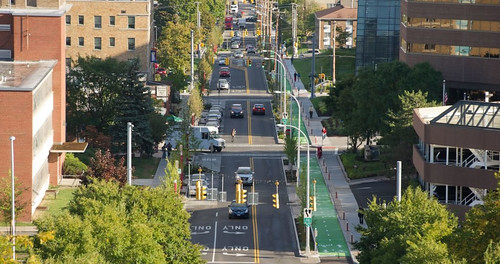
One of the facilities in the Connective Corridor program is a high profile separated cycle track for bicyclists.
Although there is some criticism that the project is shaped more to benefit the university, which is the primary funder.
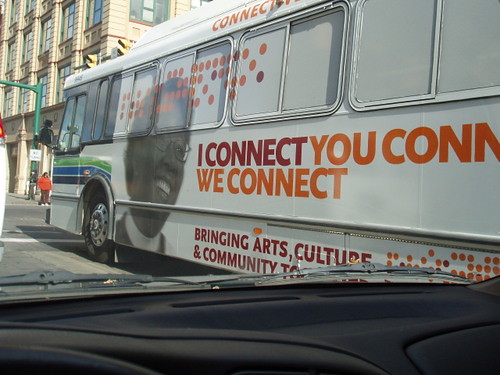
The description of the Connective Corridor in promotional materials sums up the elements that comprise a "Signature Street" or sustainable mobility district:
The Connective Corridor is a collaboration between Syracuse University, the City of Syracuse and Onondaga County to connect University Hill with downtown Syracuse. The project includes new streetscapes to make the city more pedestrian and bike-friendly, a free public transportation system with smart bus technology, a network of green infrastructure, public art, wayfinding systems, façade improvements and innovative illumination projects that highlight Syracuse’s beautiful historic buildings and public spaces. The Corridor also connects the city’s vibrant arts and cultural district, as well as downtown dining and the great local food scene. Take the bus, walk or ride your bike...Besides being a best practice example of a university taking initiative to create better connections and placemaking conditions within the city that is its home, it's an example of a university and a city joining together its resources--this latter point is important because many cities are like Newark, in running separate transit and parking systems from the university, when they would be better served by working together.
Downtown Milwaukee's street-based real-time parking wayfinding signage is a good model for the real-time signage side, because more than apps are needed to change people's perceptions and behaviors ("Downtown Milwaukee signs offer parking guidance," WUWM/NPR).
Another good example for university towns is the aforementioned Park on the Hill program in Chapel Hill.
Other elements of a sustainable mobility district. Then add other elements from the Silver Spring framework, including improvements to the biking and pedestrian environment, including a city-wide secure bike parking system, and other placemaking improvements.
Compared to Silver Spring, some other elements would need to be added for the average college town, because they already exist in Silver Spring, such as bike sharing and car sharing, but they may not be present in smaller communities like college towns outside of major metropolitan areas. Many universities have bike programs and special car sharing arrangements that can be leveraged to achieve broader sustainable mobility initiatives.
Sustainability planning. Plus, universities tend to be leaders in sustainability planning and it's a good way to engage students and faculty, who are simultaneously local residents, in directing some of these energies towards community improvement..
-- "Sustainability Plans Popular on College Campuses," Environmental and Energy Study Institute

The Indianapolis Cultural Trail is another model of high profile pedestrian and bicycle facilities that can be drawn upon by college towns.
IBJ photo.
In a smaller, more self-contained place like a college town, e.g., Newark or Chapel Hill, etc., it would probably be easier to create a one-off car sharing organization, maybe even electric based, like Blue Indy ("BlueIndy car-sharing program striving to be in black by 2020," Indianapolis Business Journal), as a way to seed the necessary infrastructure for electric car usage beyond car share.
Portland's Electric Avenue (FAQ) would be another example that college towns could draw upon in broadening their focus from "transit" to "sustainable mobility." (College towns are smaller and a better place to try to introduce e-based car services, whereas these types of programs are being implemented in larger cities where they are much harder to make successful.)
Davis, California as an important lesson for other college towns. Davis was pathbreaking in that when the university campus was created, it didn't allow cars, and specifically promoted biking. It led to the City of Davis becoming an equally committed proponent of bicycling("Davis, California - the American city which fell in love with the bicycle," Guardian)..

Bicycle racks at the University of California, Davis, 1963, by Ansel Adams
But this was in the period of widespread biking use, before automobility superseded other forms of mobility in the US. Plus, because new student cohorts need to be educated and trained each year as other cohorts graduate, transportation demand management programming needs to be constant and rigorous rather than trickle down.
Over time, biking for transportation has significantly declined, both on the campus and in the city, and other cities, which developed more advanced practices, have leapfrogged Davis ("Fifty years of bicycle policy in Davis, CA," Ted Buehler).
The lesson is that promoting sustainable mobility practice needs to be constant.
Sustainable Mobility Platform elements for a college town
(recognizing that many of these elements are likely to be present, but are probably not well integrated)
1. Integrating city and university transit into a single, unified system.
2. Ideally riding the transit system would be free, through local and university funding sources (possibly through the creation of a transportation management district and use of parking revenues).
3. Creating an integrated parking system between the city and university as appropriate, including wayfinding and valet services.
4. Transportation Demand Management programming of a very serious nature, including trip travel programs for residents and large employers aimed to getting them using other modes (e.g., the Smart Trips program of Whatcom County, Washington) and the provision of TDM information at all types of locations--schools, libraries, retail businesses, large employers, bicycle shops, etc.
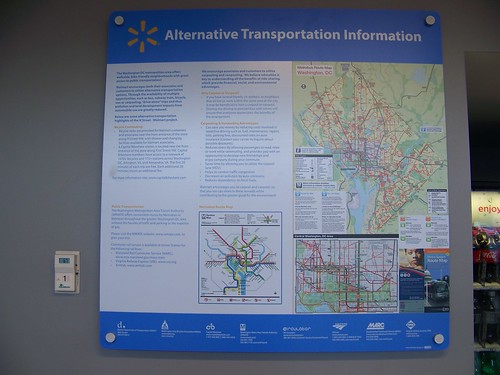
TDM wayfinding signage at a Walmart supercenter in Washington, DC.
5. Creating an infrastructure for electric car charging.
6. Creating a car share system open to students under the age of 25, that supports both one-way and two-way usage. Possibly the car share system could be comprised of electric cars.
7. Set high mode split goals for biking, walking, and transit.
8. Creating a city-university biking program, including a network of secure bike parking along the lines of the Melbourne Parkiteer system, some form of access to bikes (bike sharing), bike co-ops and an integrated network of high quality bicycle lanes, cycle tracks, and trails.*
9. Use bike provision models such as those of Ripon College, North Central College, and UCLA to provide long-term access to bikes for students and for residents, bike commuting assistance programs such as of those in UK communities like the Hackney and Hounslow boroughs in London ("Eight "mutual assistance programs" that can build support for biking as transportation") which will loan people bicycles, locks, and helmets so they can try out biking
10. The train station should be an anchor hub for bike parking and other bike services in the city, complemented by a campus-based "bike station."*
11. Connect with metropolitan-regional transit systems for a low cost transit pass for use outside of the city/campus.
12. Various pedestrian and placemaking improvements.
13. Safe routes to school programming.
14. Create zoning requirements for new construction that support high quality sustainable modes, especially biking in apartments, office buildings, schools, etc., plus electric car charging capacity, and spaces for car sharing, etc. College campuses tend to provide sub-standard bicycle parking, especially in dormitories.
The Urban Land Institute report, Active Transportation and Real Estate: The Next Frontier, describes 10 different apartment developments with extraordinary bicycle accommodations. Other examples include Plant51 in San Jose ("Commuting has never been easier when you live at Plant 51 in San Jose," San Jose Mercury News) and Via6 in Seattle ("A look inside Via6's bicycle-friendly living and cycle club in downtown," Cascade Bicycle Club).
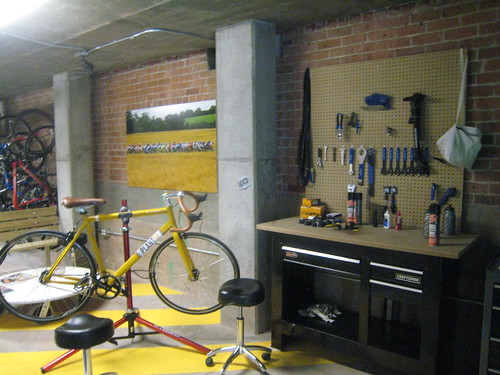
In-house bicycle repair station at the Plant51 condominium in San Jose.
In San Francisco, the 100 California building owned by Pembroke Real Estate doesn't have car parking, but after a renovation the building now has a bike parking room with space for more than 100 bikes, a bike repair station, lockers, showers and towel service.
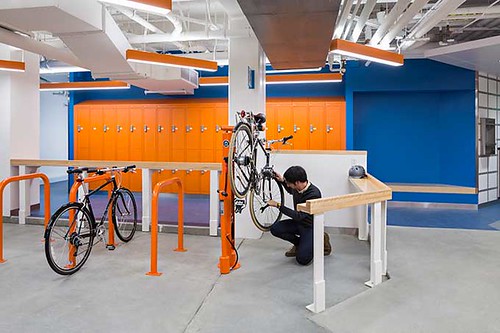
Bike Room, 100 California Building. Photo: Design Blitz SF.
Specific items for Newark
* Ideally the Wilmington MPO could work with SEPTA and the Philadelphia MPO to develop a "Cyclepoint" type program for bike parking at main train stations across the SEPTA network (in Newark, Wilmington, and Philadelphia especially), and a Parkiteer type secure bike parking program across the service areas of both planning organizations.
For Newark specifically, they should work to increase SEPTA train service between Wilmington and Newark, and to eliminate the "missing link" between the MARC and SEPTA systems.
Labels: college students and the city, sustainable land use and resource planning, sustainable mobility platform, transit, transportation planning, university-community revitalization, urban design/placemaking








1 Comments:
San Marcos to team up with Texas State on public transit plans
https://www.expressnews.com/hill-country/article/san-marcos-texas-state-bus-public-transit-18301586.php
8/18/23
Texas State. which has more than 38,000 students, currently operates a bus system, Bobcat Shuttle, that ferries students from many apartment complexes in San Marcos to different parts of the campus.
The city of San Marcos has grown rapidly, with its population jumping from about 45,000 in 2010 to more than 70,000 in 2022, according to the U.S. Census Bureau. The city’s public transportation is mainly operated through the Capital Area Rural Transportation System, a regional transit authority. CARTS serves much of the area surrounding Austin, including Bastrop, Dripping Springs and Burnet. It also offers direct routes between San Marcos and Austin.
Post a Comment
<< Home